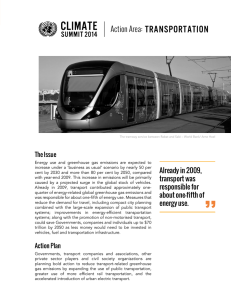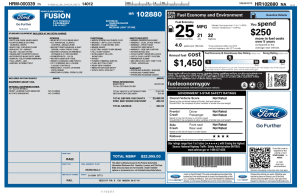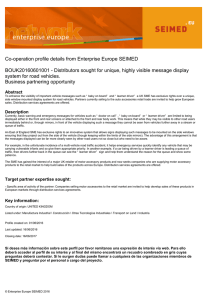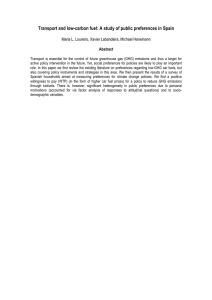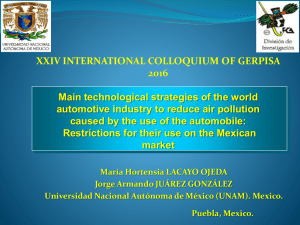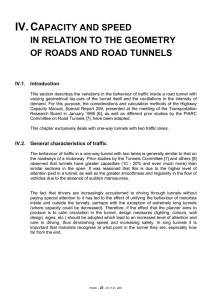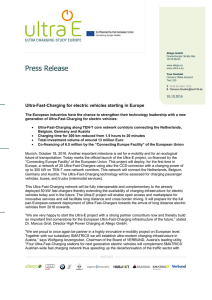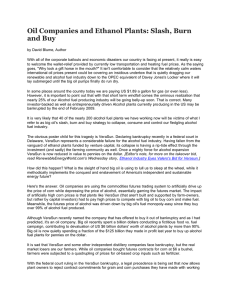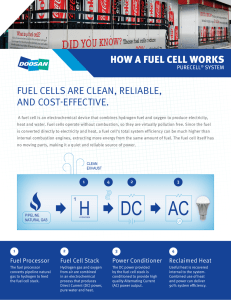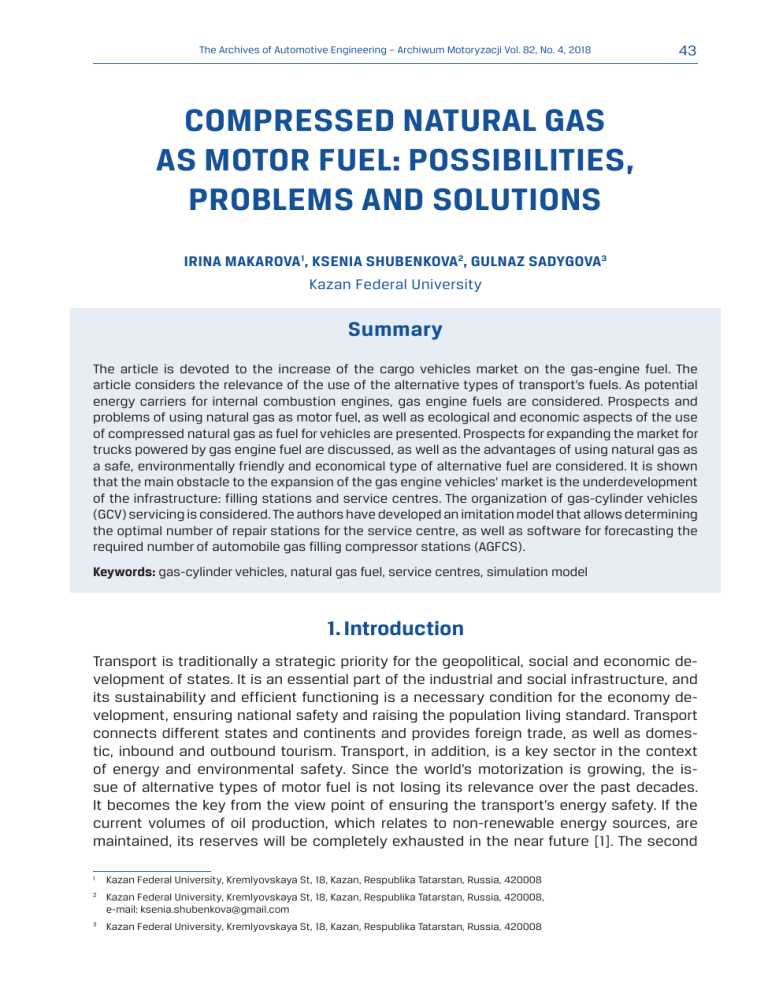
The Archives of Automotive Engineering – Archiwum Motoryzacji Vol. 82, No. 4, 2018 43 COMPRESSED NATURAL GAS AS MOTOR FUEL: POSSIBILITIES, PROBLEMS AND SOLUTIONS IRINA MAKAROVA1, KSENIA SHUBENKOVA2, GULNAZ SADYGOVA3 Kazan Federal University Summary The article is devoted to the increase of the cargo vehicles market on the gas-engine fuel. The article considers the relevance of the use of the alternative types of transport’s fuels. As potential energy carriers for internal combustion engines, gas engine fuels are considered. Prospects and problems of using natural gas as motor fuel, as well as ecological and economic aspects of the use of compressed natural gas as fuel for vehicles are presented. Prospects for expanding the market for trucks powered by gas engine fuel are discussed, as well as the advantages of using natural gas as a safe, environmentally friendly and economical type of alternative fuel are considered. It is shown that the main obstacle to the expansion of the gas engine vehicles’ market is the underdevelopment of the infrastructure: filling stations and service centres. The organization of gas-cylinder vehicles (GCV) servicing is considered. The authors have developed an imitation model that allows determining the optimal number of repair stations for the service centre, as well as software for forecasting the required number of automobile gas filling compressor stations (AGFCS). Keywords: gas-cylinder vehicles, natural gas fuel, service centres, simulation model 1. Introduction Transport is traditionally a strategic priority for the geopolitical, social and economic development of states. It is an essential part of the industrial and social infrastructure, and its sustainability and efficient functioning is a necessary condition for the economy development, ensuring national safety and raising the population living standard. Transport connects different states and continents and provides foreign trade, as well as domestic, inbound and outbound tourism. Transport, in addition, is a key sector in the context of energy and environmental safety. Since the world’s motorization is growing, the issue of alternative types of motor fuel is not losing its relevance over the past decades. It becomes the key from the view point of ensuring the transport’s energy safety. If the current volumes of oil production, which relates to non-renewable energy sources, are maintained, its reserves will be completely exhausted in the near future [1]. The second Kazan Federal University, Kremlyovskaya St, 18, Kazan, Respublika Tatarstan, Russia, 420008 1 Kazan Federal University, Kremlyovskaya St, 18, Kazan, Respublika Tatarstan, Russia, 420008, e-mail: [email protected] 2 Kazan Federal University, Kremlyovskaya St, 18, Kazan, Respublika Tatarstan, Russia, 420008 3 44 The Archives of Automotive Engineering – Archiwum Motoryzacji Vol. 82, No. 4, 2018 serious problem related to the motorization growth is the negative transport impact on the environment. Vehicles together with industrial enterprises produce black carbon and sulfur dioxide, which increases the early death risk. Even relatively low concentrations of these substances in the atmosphere cause from 4 to 22 percent of deaths at a young age (under forty years old). A very dangerous symptom for mankind is that air pollution increases the probability of having congenital pathologies on children [2]. According to the European Commission, in 27 EU countries, transport is the second largest greenhouse gas (GHG) emissions source after the production sector, with the such emissions’ dynamics from transport being higher than in any other energy sector [3], Thus, transport accounts for more than 90 % of direct transport emissions [4] and continues to increase in most countries due to the growth in road transport. Emissions from vehicles are one of the most serious air pollution causes in large cities. Thus, in Moscow and other large Russian cities the automobile emissions’ proportion makes more than 90 % of total emissions amount of polluting substances in the atmosphere. In cities with less developed industry, the proportion of the automobile exhaust gases contribution is slightly less (about 80-90 %). In Russia as a whole, emissions of vehicles into the atmosphere account for 42 % of their total number [5]. Economical and environmentally friendly transport is the main factor in the concept of the transfer to low-carbon economy which is one of the priority areas for the sustainable development of Russian socio-economic system. It facilitates the transition to green growth, reducing the load on the environment, increasing the natural resources efficiency. 2. Environmental problems caused by motorization Reduction of the black carbon (BC) emissions from various combustion sources is considered as an urgent political challenge to address climate change, air pollution and health risks. Vehicles make a significant contribution to the overall anthropogenic emissions of BC and urban BC concentration. The article authors [6] show that there is much greater uncertainty in the emission factors for light diesel passenger vehicles (LDPV) compared to heavy diesel vehicles, so further research is needed, as well as the development and implementation of adequate measurement techniques. As a pioneer in the fight against vehicle emissions in China, Beijing published in August 2013 an “Air Cleanup Action Plan” for 2013-2017 to improve air quality in cities. This document contains the emission control policy and strategy that should be adopted for road vehicles in Beijing. The paper [7] assesses historical and future trends and uncertainties in vehicle emissions in Beijing from 1998 to 2020 by applying a new emission factors model to Beijing vehicle fleet. The article authors [8] notice that vehicle emissions have become one of the key factors affecting air quality in cities and climate change in the Pearl River Delta region. Therefore, analyzing different scenarios to transport system’s development, the authors believe that the government should adopt long-term emission control strategies, such as updating emission standards, fuel quality and bus priority strategies, and long-term pollution control. The fight against vehicle emissions has become one of the most important problems in the air pollution control field in China. The Yangtze River Delta Region (YRD) is one of the most prosperous and densely populated China regions which The Archives of Automotive Engineering – Archiwum Motoryzacji Vol. 82, No. 4, 2018 45 faces enormous pressure to reduce vehicle emissions and improve air quality. The article [9] provides a very timely analysis of the vehicle emissions control policy in Chinese cities to improve air quality in the short term and makes it clear that it is significantly difficult to reach the required reduction of vehicle emissions NOx. The authors of [10] have investigated the space-time emissions of NOx, which were measured for buses with conventional transmission and electric hybrid buses along the gradient lines of kinetic load and ambient temperature. The authors believe that their proposed methodology can be used in future connected vehicles, equipped with computing power, data storage capability and improved sensor technology to optimize emissions depending on the spatial location. The study [11] was devoted to a pilot research of the potential to reduce the greenhouse gas emissions and to improve the engines’ energy efficiency using natural gas as the main fuel, and vehicle’s dual-fuel engines on compared to conventional diesel engines. The article authors have performed a technical and economic assessment of the dual-fuel engines used in heavy-duty vehicles, taking into account the entire life cycle. The increasing motorization level forces the international community to find solutions to reduce the vehicles’ negative impact on the environment: toughening requirements to vehicles environmental safety, the strict standards introduction (EURO). More economical and environmentally friendly transport contributes to the “green” growth, burden reduction on the environment, increasing the efficiency of the natural resources’ use. The close attention of researchers of the prospects for the transport sector’s development is due to the fact that many factors require the development of new methods to predict their future. These factors affect sustainability of the transport system and at the same time can have serious consequences for other areas of activity. So, the article author [12] uses the scenario analysis method to compare four variants of the transport sector development. In the letter [13], the tendencies of introduction of technical and technological innovations are investigated. The performed researches analysis shows that at the moment the technological development process is studied not only by technical specialists and natural-sciences researchers, but also by analysts in economics and in social sciences. The author notes that the forecasts of the transport sector’s development have shifted from a techno-oriented point of view towards a process-oriented approach. The authors of scientific studies indicate several ways to reduce energy consumption and, accordingly, emissions in the transport sector. Basically, the work is carried out in two directions: •New technical and technological solutions aimed at improving the fuel quality, switching to low-carbon fuels, changing the obtaining energy way, fundamentally new types of power-generating plants, as well as the use of new materials and design solutions to reduce the vehicle weight. •organizational and management solutions to vehicle operation efficiency increasing, including through transportation process optimization, as well as the organization of vehicles high-quality and timely service and repair, failures prevention, increased operational reliability and safety. 46 The Archives of Automotive Engineering – Archiwum Motoryzacji Vol. 82, No. 4, 2018 The authors of the article [14] divide the directions of improving energy efficiency and environmental friendliness of vehicles into five categories: 1.Improving vehicle technology. Technical improvements are provided by alternative technologies (electrification, batteries, fuel cells, etc.), elevating the safety and manageability of vehicles. 2.Developing lower carbon fuels. This direction is devoted to the energy-efficient fuel mixtures search and biofuel. 3.Increasing the efficiency with which vehicles are used (occupancy rates and driving style). In passenger transportation, the occupancy rates can be improved by car-sharing and on-road fuel efficiency through eco-driving. In freight transport, possible projects include improved logistics and driver training. 4.Ensuring that the most efficient vehicles are used on any given journey. This way is associated with the development and implementation of packages of so-called “soft measures”, which are aimed at changing transport behavior. This includes encouraging clubs with cars and work-based travel plans to encourage uptake of alternatives to the car and the use of telecommunication for work purposes. 5.Reducing the need to travel. Information and communication technology (ICT) systems can make travel more efficient (for example, through GPS-based systems, GLONASS) and telecommunications, such as telework, videoconferences and home purchases, for spatial planning of new housing and business developments. The implementation of SMART-CITY projects expands the possibilities for creating and realization the of such mobility’s concept. 3. Advantages of the use of gas as motor fuel Objective prerequisites for the interest growth in using gas as motor fuel in recent years are higher energy and environmental performance than oil fuels. Natural gas of all widely used motor fuels and technologies, provides the safest exhaust gases emissions, has a significant effect on lubricating oils (30-40 %). Thus, the conversion of vehicles from gasoline to gas makes it possible to reduce the harmful emissions five times, on average, and the effect of noise by half. In addition, the gas does not contain the main pollutant of gasoline – sulfur, so even the most refined gasoline cannot be compared in pure combustion with gas fuel. Another important factor is a more stable price for gas (two times lower than diesel fuel), and at the same time a higher efficiency: the energy is almost the same – 0,95:1. Natural gas is one of the most common and demandable primary energy carriers on the Earth planet. According to the basic scenario of the International Energy Agency forecast, world natural gas consumption can grow to 3797 million tons in oil equivalent in 2030 (over 4 trillion cubic meters). The basis of natural gas (up to 98%) is methane (CH4), which has no color and odor; lighter than air; is chemically inactive, easily soluble in gas and liquid, for example, in air, water or petroleum. Natural gas has mainly organic origin. The Archives of Automotive Engineering – Archiwum Motoryzacji Vol. 82, No. 4, 2018 47 Fig. 1. Key benefits of using natural gas as motor fuel Demand for natural gas for transport continues to increase steadily. Along with traditional consumers (automobiles of various types) natural gas becomes an attractive fuel for rail and water transport. More and more such projects appear in the world. In the near future, works on transferring the aviation to methane will be resumed. According to NGV Communications Group, by the end of 2014 the main indicators of the natural gas use by the road transport in the world were: •vehicles fleet run on methane - 22.3 million units (world fleet on CNG and LNG grew by 5.6 times in 10 years); • CNG filling stations - 26.5 thousand; •demand for CNG / LNG (according to the report) - 29.4 billion cubic meters, estimated at least 40.4 billion cubic meters. In Russia, the AGFCS network has more than 400 stations, of which 378 belong to Gazprom and 44 are private [15]. By 2015, the model range of gas vehicles of factory production had reached 180 units: passenger cars, trucks, buses, communal and special ones. Compression and liquefaction of natural gas are used to reduce the physical volumes. In a vessel with a capacity of 1000 liters under normal conditions (pressure 1 atmosphere and temperature 0°C) one cubic meter of natural gas will enter (normal - nm3), at a pressure of 200 atmospheres - about 220 nm3, and at a temperature of minus 162°C - 600 nm3. In other words: with the same capacity of fuel tanks, LNG vehicle will be able to drive almost three times as farther as the CNG vehicle. For the transport that performs trips over long distances, this is of decisive importance. 48 The Archives of Automotive Engineering – Archiwum Motoryzacji Vol. 82, No. 4, 2018 Table 1. Comparative table of buses operation cost calculation using diesel fuel and compressed natural gas in State Unitary Enterprise “Mosgortrans” Bus, powered by gas fuel Main technical and economic indicators Bus, powered by diesel fuel LiAZ -529271 LiAZ -529222 The cost of the bus, rubles 7 672 550 7 161 350 Fuel consumption per 100 km 69 m3 48 liters The price of fuel, rubles 12,57 26,99 Variable operating costs for 800 thousand km mileage: 10 778 640 13 500 160 Expenses for fuel, rub 6 938 640 10 364 160 Maintenance and repair costs, rub 3 840 000 3 136 000 Environmental class EURO-5 (EEV) EURO-5 Engine power, kW 206 184 External noise, dB 76 80 The economic effect per vehicle unit when using CNG for the period of operation, RUB Economy - 20% 2 210 320 SOURCE: Moscow City Transportation Department, analysis of JSC Gazprom Neft [16] 180 units of such buses operate on the routes of the Moscow Northern Administrative District since 2012. Accumulated in Moscow city experience of such buses operation shows its considerable advantage in comparison with diesel analogues both from an ecological and economic points of view. A promising area for the development of natural gas as a motor fuel in Moscow is the transfer of municipal road vehicles and communal vehicles to CNG. Natural gas as a motor fuel is used in following states: compressed natural gas (CNG), liquefied natural gas (LNG). CNG vehicles are already used worldwide, and the technology for obtaining, storing and using it has already been developed. Compressed natural gas as a motor fuel is widely distributed in countries with their own natural gas reserves. These vehicles produce only a small amount of carbon dioxide and have a high octane number, so they are suitable for use as a public transport. In some countries, the CIS is used in public transport. Among all alternative fuels, compressed natural gas (CNG) is considered one of the best solutions for replacing fossil fuels because of its worldwide availability, clean combustion, fuel-economicity and adaptability to gasoline and diesel engines. The bibliography [17] considers the potential of CNG as a transport fuel. Natural gas is a widely used alternative fuel for a many reasons variety, and is also produced in many regions of the world in order to ensure a stable supply. There are following problems and researcher ways in the literature [18]: • Regional experience of using CNG vehicles • The economic aspect of CNG vehicles • CNG engine's design, control and performance • Combustion and fuel injection characteristics of CNG engines The Archives of Automotive Engineering – Archiwum Motoryzacji Vol. 82, No. 4, 2018 • • • • 49 CNG/diesel dual fuel operations Hydrogen enriched CNG vehicles The environmental aspect of CNG vehicles The safety aspect of CNG vehicles Promotion of the natural gas vehicles’ use is considered as one of the most important sustainable transport strategies. In recent years, China has made significant progress in promoting natural gas vehicles, and in 2014, 4.6 million natural gas vehicles represented the world’s largest natural gas vehicles fleet. The article [19] deals with the development of natural gas vehicles in China on the basis of technical and economic framework with a triple perspective (fuel-vehicle-infrastructure). The article authors the believe that local authorities should develop special plans and strategies to support the further development of CNG / LNG refueling infrastructures. In some countries, researchers [20] are attempting to reduce pollution through the use of vehicles operating on hydrogen-enriched compressed natural gas, mainly vehicles with medium and heavy-duty engines. In general, under specific circumstances, thermal efficiency of this HCNG engine is much better than the engines with LNG, not allowing a harmful emissions’ high level. Currently, natural gas is gaining interest as a transportation fuel, as more than 19 million vehicles used natural gas as fuel. The document [21] presents global prerequisites, prospects and problems of fuel use on CNG and LNG, as well as environmental and economic aspects to use compressed natural gas as fuel for transformation. The main indicators chosen for the comparative assessment of natural gas as an automotive fuel are: economic indicators, ecological efficiency and safety. The document [22] analyzes the favorable factors and barriers to development of natural gas vehicles (NGV) in China. For the further development of NGV in China, the following strategies are proposed: (1) improvement of the natural gas delivery infrastructure throughout the country; (2) it is reasonable to reduce the relative price of natural gas in comparison with gasoline; (3) give priority to middle-income and medium-sized cities and towns, since it is easier to place natural gas refueling stations is easier in these areas; and (4) promote the use of NGV in the private sector. NGV importance in world over is growing, especially in Latin America and Asia, where a megacities large part is located. All countries that in an appreciable amount use natural gas as vehicles fuel, first invested in the necessary infrastructure and developed special support programs. The article [23] discusses the approaches and results of the introduction NGV in seven countries with different experiences in order to gain an understanding of the barriers to the NGV market development in Nigeria. The article authors [24] consider that in European countries, political support and special incentives are necessary to stimulate the natural gas as vehicles fuel use, since the use of natural gas in conventional engines has relatively few problems and is technically simple, but it has significant environmental benefits. Considering the market of vans with LNG in the UK, the authors of [25] identified a number of barriers, the most important being the lack of refueling facilities, but the authors also indicate the possibilities, namely fuel costs, as well as the potential to pollution's reduction . 50 The Archives of Automotive Engineering – Archiwum Motoryzacji Vol. 82, No. 4, 2018 The article authors [26] note that, despite the fact that private investments exceed two billion euros, and tax breaks amount to more than 500 million euros, the NGV market share in Germany lags far behind expectations and market trends in other countries. The authors conclude that the coordination’s rejection in additional markets, the artificially created maintenance stations monopoly on highways, imperfect information, limited consumer rationality and problems with major agents are the most notable market failures that impede the development a NGV market functioning. The article authors [27] consider that in Italy the main weak point for LNG as fuel is its distribution and, in particular, the supply process. Thus, in order to assist in the development of this alternative fuel, it is important to basically solve the problem together with the lack of rules and standards on the ground, this document is intended to emphasize the criticality of LNG supplies for developing new alternative fuels and give indications of the best supply options and parameters that affect on them in order to provide a useful assessment tool to support the introduction of LNG into the Italian market. In Japan, two oil crises in the 1970s provoked the introduction of "next-generation vehicles". Examples include electric vehicles with batteries (BEV), compressed natural gas vehicles (CNGV) and hydrogen fuel cell vehicles (FCEV). The study [28] examines the fuel supply infrastructure for the new generation vehicles, in particular its technical objectives, problems and risks, reviews of Japan's past approaches and efforts, as well as prospects for the future. The natural gas abundance in the United States due to the existing natural gas reserves number and recent success in the extraction of non-traditional reserves is one of the main factors behind the natural gas prices low level. The question arises, what is the optimal use of natural gas as a transport fuel. The results of the study [29] show that the dependence on the natural gas combustion efficiency at a fixed power can outweigh the electric vehicles inherent efficiency, thereby emphasizing the studying importance the energy use on a “good for the wheels” basis. Long-distance passenger transportation is an energy consumption significant source, greenhouse gas emissions and emission criteria for pollutants in the United States. The results show that intercity buses are usually the most economical way and provide the lowest emissions for each passenger for the entire range of distances traveled. According to experts, in the coming years CNG and LNG are the only real alternative to gasoline and diesel fuel. The use of natural gas as a transport fuel is associated with a number of potential benefits to the environment, namely, emissions to the atmosphere and noise. Compressed natural gas is considered a “cleaner” fuel compared to other fossil fuels [30]. The study authors [31] compared the levels of environmental pollution in Delhi before and after the project on the transfer of public road transport in 2002 to compressed gas. A reduction in the number of suspended particles by 14 %, CO by 10 %, SO2 by 22 % and NOx by 6 % was found. One of the constituent parts of the internal combustion engines' exhaust gases is solid particles. CNG is potentially beneficial fuel, since particulate emissions are significantly reduced using NG fuel, because NG does not contain aromatic and polyaromatic compounds, and contains less dissolved sulfur compounds than petroleum fuel. The Archives of Automotive Engineering – Archiwum Motoryzacji Vol. 82, No. 4, 2018 51 The study authors [32] researched the proportions of CO, HC and NOx in the emissions of 9 vehicles under 8 operating conditions. Based on the data obtained, the effect of operating conditions and fuels on pollution levels was analyzed. Based on this study analysis, the authors obtained the following conclusions: 1.CO emission correlates with speed. The emission level is higher at high speeds (60-75 km/h) than at low speeds (20-30 km/h). 2. Vehicles produce more solid particles when burning gasoline than the CNG at 2.39-12.59 times. 3.The impact of operating conditions on NOx emissions is not obvious and varies depending on the vehicle's movement conditions. Although CNG vehicles produce more NOx than gasoline vehicles, the range of the ratio is 1-1.2, which is very small. Thus, the contribution of CNG to the formation of smog can be less than that of vehicles with gasoline and diesel engines. But, there are studies [33] in which the results of GHG emissions were unsatisfactory or even worse than for gasoline vehicles, due to inadequate CNG vehicles maintenance. 4. Simulation as one of the ways to predict the need to expand the gas-cylinder vehicles’ infrastructure Table 2. Provision of infrastructure for vehicles run on various types of fuel represented on the market of the Russian Federation Available infrastructure Fuel type Auto refueling Service nertwork Petrol >70000 An extensive network Diesel >70000 An extensive network Liquefied petroleum gas >1800 Average development of infrastructure. The absence of factory vehicles models Hybrid >70000 Average infrastructure development Electricity About 40 charging stations Extremely limited network Compressed natural gas 250 Limited Infrastructure Since vehicles with gas engine fuel differ from traditional ones, there is a number of problems that arise when their share in the fleet increases. Studies analysis on the gas-cylinder vehicles (GCV) market development's prospects showed that almost all researchers consider the GCV maintenance infrastructure development as a necessary condition to success of this direction. This provides to expansion of the gas filling compressor stations network, as well as a network of service centres that have areas for gas-cylinder equipment servicing. The branded service system evolution, as well as the GCV reliability and safety, in particular during the warranty period of operation, ensures trouble-free operation, which leads to increased customer confidence in the brand. 52 The Archives of Automotive Engineering – Archiwum Motoryzacji Vol. 82, No. 4, 2018 The GCV market development is impossible without the creation of a network of specialized service centers. Service centers can be created both in new premises, and on repair areas operating servise centers existing [34]. The production base of enterprises engaged in servicing and repairing GCV should meet the requirements of relevant regulatory documents that control safety standards for buildings, facilities, premises, equipment. To create new station in service center, you can consider the mobile service center variant with using frame-tent constructions. The organization of the service is the most important task, since the maintenance and repair of GCV differs from the maintenance of basic diesel fuel vehicles models, because there is a need for additional work related to the availability and specificity of the maintenance of gas equipment. Special sections for GCV servicing and repairing include stations: gas accumulation, cylinders degassing; GCV maintenance and current repair; adjustment and repair of automobile gas-fuel system; storage area of fuel system components; a storage area for emptied automotive cylinders; Compressor with compressed air. Maintenance and repair of all GCV units and aggregates, with the exception of the gas supply system, are making in the production building together with liquid fuel vehicles. For GCV, as well as for vehicles on traditional fuel, the following types of services are provided: • daily maintenance (DM); • the first maintenance (M-1); • second maintenance (M-2); • seasonal services (SS). However, in addition, for gas-cylinder vehicles with a periodicity of 3 years, it is necessary to carry out a technical inspection of gas cylinders. It is not mandatory to organize the special station for these operations in service center, therefore it is possible to transfer the cylinder’s certification to the outsourcing. Fig. 2. The typical scheme of the technological process for maintenance and repair of diesel and gas-cylinder vehicles The Archives of Automotive Engineering – Archiwum Motoryzacji Vol. 82, No. 4, 2018 53 Operations on gas supply system (GSS) to M-1 and M-2 are performed with the maintenance periodicity of the GCV itself. Seasonal maintenance of gas equipment is combined with the next M-2 and is performed once a year. Science the GCV design differs from the base vehicles presence of GSS only and GCV fleet size is still quite small, therefore the organization of the GCV service on the basis of existing dealer network is the most rational solution. The scheme of organization of GCV maintenance and repair (M&R) depends on the type of cylinders used, the structure and number of the fleet, the available production areas, the accepted technology of GCV maintenance and their storage, the available volume of capital investments in the construction of the production base of the enterprise. Fig. 3. Algorithm for the service center operation Maintenance and repair of all units and aggregates of GCV, except for the gas supply system, are produced in the service center in conjunction with liquid fuel vehicles. A more detailed algorithm for the service center operation to servicing vehicles operating both on CGV and liquid fuel is shown in Fig. 3. In this algorithm, the following possible cases are considered when referring a customer to a service: 54 The Archives of Automotive Engineering – Archiwum Motoryzacji Vol. 82, No. 4, 2018 • liquid fuel vehicles: scheduled maintenance; repair; • gas-cylinder vehicles: gas-cylinder equipment (GCE) regularly, the vehicle is working properly; scheduled maintenance; GCE properly, vehicle is defective; GCE defective, vehicle is properly; GCE defective, vehicle is defective In the maintenance and repair (M&R) organization of GCV, as well as their storage in enclosed spaces, two fundamentally different schemes are possible: •SCHEME 1, at which the GCV enters the M&R zone and to the storage area with gas cylinders emptied from the gas; •SCHEME 2, at which the GCV enters the M&R zone and to the storage area without preliminary gas discharge from the car's cylinders, provided the gas-fuel equipment is tight and the pressure in the working cylinder does not exceed 5.0 MPa. The valves of the remaining cylinders must be closed. SCHEME 1 is recommended when the free volume of the M&R zone, or the storage of the GCV is less than allowable, or the investment in the reconstruction of the plant's production area associated with the creation of emergency ventilation and alarms, etc. are limited. If SCHEME 1 is used, the requirements for service centers for liquid fuel vehicles should be met without additional reconstruction measures. SCHEME 2 is recommended when the free M&R production areas’ volumes and storage of GCE are more than admissible or when the volume of capital investments in the reconstruction of the services production base is not a limiting factor. The choice of the organization M&R scheme depends on the volume of used cylinders, the GCV fleet structure and quantitative, the existing production areas and their geometric dimensions, the accepted technology of maintenance of the GCV and their storage, the available volume capital investments in building or reconstruction autoservice center. When calculating the maintenance stations number for the GCV, it should be borne in mind that the maintenance periodicity and the downtime in M&R zones per 1000 km of mileage for the GCV are set to the same as for the base models on liquid fuels [35]. Given that the main difference between servicing vehicles on gas is due to the power unit specificity and the fuel type, the normative documents on the technological process for this vehicles type were used in the simulation model development. The failures distribution laws by the power unit's main elements, fuel system and gas equipment, frequency of calls to the dealer-services center and other information were studied. The model, which allows to determine the optimal station number to existing vehicles fleet, was realized using AnyLogic. The initial data to variants analysis during the model experiment was information about the failures from the reclamation reports after visits The Archives of Automotive Engineering – Archiwum Motoryzacji Vol. 82, No. 4, 2018 55 to service center. In the model, the algorithm described above was implemented, which ensures the maintenance and repair of vehicles with both a diesel engine and a gas engine. In addition, there is a possibility of delays in repair, due to the spare parts lack (Fig. 4). It is currently planned to expand the fleet of GCV (in particular, garbage trucks and other municipal equipment). This will allow to model's verification and validation, as well as develop recommendations to branded service's system rational development. Fig. 4. The model of the service center built in AnyLogic 5. Predicting the need in the automobile gas filling compressor stations expansion Automobile gas filling compressor stations (AGFCS) for today are the only real alternative to refuels for automobile liquid fuels. The number of AGFCS stations in the Russian Federation is approximately 250 units, which is quite small and, as a rule, AGFCS are located far from vehicles owners. Unlike auto filling stations and auto gas filling stations, which only sell different types of motor fuel, AGFCS stations are the objects where the motor fuel - compressed natural gas is produced from raw natural gas coming through the gas pipeline. The quality of the released compressed natural gas (CNG) is determined by GOST 27577- 87 [36]. The raw natural gas, which has been previously cleaned from the dropping liquid and mechanical admixtures, is compressed, drained and collected in accumulators (groups 56 The Archives of Automotive Engineering – Archiwum Motoryzacji Vol. 82, No. 4, 2018 of cylinders) for subsequent distribution through gas filling columns. Refueling of vehicles with natural gas is carried out to a working pressure of 200 atmospheres, and mobile auto gas refuels (MAGR) - up to a pressure of 250 or 320 atmospheres. Automobile gas-filling compressor station consists, as a rule, of a gas compressor, receivers, a filtration and drainage system, filling columns, etc. AGFCS can also be implemented in conjunction with a auto filling station. The construction of such a multi-fuel station, compared with the traditional auto filling stations is more expensive by 30 %. In the absence of a supply pipeline, it is possible to use a subsidiary filling station. Fuel is delivered here with the help of mobile trailers CNG, previously tucked into the leading station. The standard solution is based on hydraulic compressors, capable of operating with a input pressure wide range and requiring a small initial investment. Currently, the NGV fleet in the zone of availability of the majority of AGFCS is much lower than the optimal one. In the world practice, for every 500 units of automotive equipment converted to gas, there is one automobile gas filling compressor station. On the other hand, it is necessary a significant NGV fleet to ensure the profitability of AGFCS to load by 60-80 %. And here MAGR is an object of increased interest, both from the side of the autofirms and from the owners of CNG refueling stations. In this case, MAGR performs the function of transfering refueling of compressed natural gas to consumers up to its delivery directly to the automobile enterprises. MAGR have a number of advantages over smallsized AGFCS refueling stations. First, the MAGR is cheaper than AGFCS of low productivity. Secondly, MAGR requires a much smaller amount of site facilities and can be located directly on the available areas. On the other hand, the use of MAGR allows increasing the productivity of the existing AGFCS, while their refueling can be carried out at night, when car refueling is sharply reduced and a reduced electricity tariff is in effect [37]. Not all countries provide data about domestic market, including such large consumers as China, Pakistan, Thailand, Uzbekistan. In Europe, 1.4 million vehicles operate on methane; more than 4 200 gas stations were built; the accounted consumption of natural gas by road transport in 2014 was 2.84 billion cubic meters. Gazprom Group makes a significant contribution to this development – both in Russia and abroad, including the European market. This company makes an important contribution to the development of gas-refueling infrastructure [38]: •In 2013 in the City of Olsztyn (Poland), Gazprom Group joined Solbus in commissioning Europe’s first 11 LNG-powered city buses. In February 2015, in Warsaw, Gazprom and Solbus implemented a similar project resulting in the commissioning of 35 LNGpowered buses. •In Germany in 2016, Gazprom Group established the new company Gazprom NGV Europe (NGVE), which will focus on further development of NGV sector in Europe. Currently, NGVE is the operator of 49 automatic gas-filing compressor stations (AGFCS). •In the Czech Republic, by 2017 Gazprom Group subsidiaries and affiliates own 15 gasfilling stations. In addition, the AGFCS controlled by independent companies are supplied with natural gas from the Vemex portfolio. The Archives of Automotive Engineering – Archiwum Motoryzacji Vol. 82, No. 4, 2018 57 Company takes a proactive stance in international and national organizations to promote LNG as a fuel for freight and urban municipal vehicles, as well as sea and river vessels. One of the Gazprom Group companies, which is active in the global gas motor fuel market, is LLC Gazprom Export. Its task is to develop client database and to ensure the gaspowered fuel export from Russia to abroad. To make this, Gazprom Export coordinates the work of many foreign companies. Some of them are engaged not only in the gas motor fuel marketing, but also in its production and retail sales in European countries. •In Germany, the subsidiary company of Gazprom Germany is the operator of 34 CNG stations. •Vemex and Gazprom Germany, which are part of Gazprom Group, own 14 CNG filling stations in the Czech Republic, including 1 garage, and are planning to expand the network in Slovakia. •In Poland, Gazprom Germany together with the local bus manufacturer Solbus and the transport company MZA, implemented a pilot project that allowed residents of several Polish cities to evaluate the LNG municipal buses advantages. In 2013, Gazprom Germany and Solbus began supplying 11 LNG buses to the Olsztyn - northern Poland city and signed a contract for the delivery of 35 such buses to Warsaw, as well as the development of a filling infrastructure. New environmental standards “Euro-6”, which were introduced in 2015, have made environmentally friendly buses on methane even more competitive than diesel ones. •In Italy, Promgaz, a subsidiary of Gazprom, is striving to become a strong player in the market of the country, which is the European leader in the segment of gas engine fuel. The company is engaged in market research, selection of partners, interaction with national and European authorities, as well as technology exchange. In this case, we are talking not only about vehicle's compressed natural gas, but also about liquefied natural gas for freight transport and navigation. •In Croatia, in September 2013, a road map was signed with LNG Croatia, whose goal is to implement pilot projects for gasification of the country’s bus fleets. Gazprom Group is expanding its presence in the gas engine market not only in Europe. So, in 2013, Gazprom and Petrovietnam set up a joint venture PVGazprom NGV. The new company will manufacture gas motor fuel in Vietnam. The issue of developing a natural gas filling network is very relevant for almost all regions of the world. In Europe, for example, the through passage of gas vehicles only on methane without switching to gasoline is not possible. However, the need to create a gas filling infrastructure was sussed at the level of the European Union, and on October 1, 2014 a decision was adopted obliging the governments of the participating countries to develop gas stations' specific construction programs with a step of 150 km along the trans-European transport mains, and a cryogenic automotive filling station (KrioAFS) for LNG refueling - at 400 km intervals. At the same time, the European Commission is ready to co-finance this construction. Based on the recommendations of the European Union, the gas stations’ number in Europe should be increased from 4,256 stations (in 2015) to at least 18,000 stations. It was stated that the national rules for the design, construction and operation of refills stations 58 The Archives of Automotive Engineering – Archiwum Motoryzacji Vol. 82, No. 4, 2018 for natural gas, hydrogen and electricity should be harmonized within the whole of the European Union, and later within the whole of Europe [39]. We should not forget that in the world gas-motor fuel market already provides working to 800,000 technicians and workers. If we take the average annual growth rate of demand for methane to be 16.5% (on the horizon of 10 years), then the global annual consumption of transport can reach 75 billion cubic meters in 2020. And this is without taking into account the volumes of gas for bunkering vessels of water transport. Currently, vehicles’ natural gas is used in 85 countries around the world. AGFCS and KrioAFS are already built in 2900 settlements of the planet. Nearly 1,400 gas stations are under construction. According to NGV Journal experts, by 2020, 30,000 refueling columns on the Earth will be refueling vehicles with methane. Increasing the comfort of refueling is facilitated by an increase in number of home-type refills - automotive gas-filling compressor units (AGFCU). There are 9800 such station in the world now. When designing a long-term strategy to AGFCS network development, it is necessary to take into account the prospects for expanding the vehicles fleet on alternative fuel, as well as the risks that accompany this direction development. The developed method makes it possible to calculate the forecast of the demand for AGFCS under optimistic and pessimistic scenarios of the growth in the number of GCV fleet as well as to assess the situation in the case of a fixed risk reducing its growth. Fig. 5. Algorithm for forecasting the need for development of the AGFCS network The Archives of Automotive Engineering – Archiwum Motoryzacji Vol. 82, No. 4, 2018 59 Calculation of the need for AGFCS, depending on the vehicles fleet number is performed as follows. At the initial stage, the input data are entered: the calculation period is T, the number of gas-cylinder bus fleet for the period - A, the number of other GCV for the period - B, the permissible fleet size reduction factor - S, the standard types and sizes AGFCS (in capacity) - Z. Further, if in accordance with the trend of the forecasted year, the AGFCS capacity will meet the needs and in two years with the numbers GCV fleet's growth, the need for AGFCS construction is absent. If the increase in the number of GCV is forecasted and the construction of new AGFCS is required, then the necessary increase in the capacity of AGFCS is predicted: ∆t=(Аt+2-Аt)·296 + (Bt+2-Bt)·104 where, 296 – number of buses arriving at AGFCS for gas filling; 104 – number of another GCV arriving at AGFCS for gas filling; Bt+2 – number of another GCV fleet on calculated period; Bt – number of another GCV fleet on current period; Bt+2 – number of bus fleet on calculated period; Bt – number of bus fleet on current period. If, as a result of the fleet's number increase, the need of arriving at AGFCS for gas filling runs exceeds the capacity of existing AGFCS Δt <Z1, then a decision is made to build a new AGFCS. When deciding on the construction, it is necessary to choose from the existing standard size range AGFCS the option that is more in line with current and prospective needs: (Pt)m-1 = (Pt)m-1 +1 ∆t=∆t-Zm-1 To simulate the scenario for the development of the gas-cylinder vehicles’ fleet and the need for refueling under the influence of various risks types, a reduction factor of the fleet number is used, S, which shows the permissible lower limit of the number of vehicles ∆tS=∆t·S. Calculation of the need for refueling for this case is similar. This method allows you to determine the required number of AGFCS of a certain capacity and for a certain period, taking into account the different risk types impact, which contributes to a more justified choice of the fleet expanding strategy GCV in the region. The algorithm of this method is shown in Fig. 4. Software based on this algorithm, was developed. It helps to automate the calculation of the demand for AGFCS, depending on the number of vehicles and possible risks. 6. Conclusions World trends indicate the measures taken to ensure the transition to environmentally friendly modes of transport, at the same time, in Russia, at the moment, gasoline and diesel actually remain monopolistic types of motor fuel. Since vehicles with gas engine 60 The Archives of Automotive Engineering – Archiwum Motoryzacji Vol. 82, No. 4, 2018 fuel differ from traditional ones, there are a number of problems that arise when their share in the fleet size increases. The most important of them depends on the demand and satisfaction of the owners of vehicles, their reliability and the development of the corporate service system. Despite the prospect of using natural gas as an economical and environmentally friendly motor fuel, there are a number of problems that prevent its use. The peculiarity of gas engine technology is that it requires more frequent refueling, which, in turn, requires the denser network of gas filling stations. So, the development of the infrastructure involves expanding the network of gas-filling compressor stations, as well as expanding or upgrading the network of service centers. When upgrading the service centers, it is necessary to take into account the existence of the free space. If the volume is less than the normative one, it is necessary to provide measures to install a continuous system for automatic control of the air environment and the sensors for explosive concentrations, emergency ventilation, basic and emergency lighting in an explosion-proof design. When creating new areas, promising options are the use of the frame and tent structures for service centers. References [1] Health co-benefits of climate change mitigation Transport sector. World Health Organization (WHO). [2]Carlos Dora, Jamie Hosking, Pierpaolo Mudu, Elaine Ruth FletcherUrban Transport and Health. Module 5g. Sustainable Transport: A Sourcebook for Policy-makers in Developing Cities. Eschborn, September 2011. [3]Smarter, greener, more inclusive? Indicators To Support The Europe 2020 Strategy Printed by Imprimerie Centrale in Luxembourg Manuscript completed in July 2018. http://ec.europa.eu/eurostat/documents/3217494/9087772/KS-02-18-728-EN-N.pdf/3f01e3c4-1c01-4036-bd6a-814dec66c58c. [4] Inventory of U.S. Greenhouse Gas Emissions and Sinks: 1990–2015. [5] Air Pollution in Russia: Real-time Air Quality Index Visual Map. http://aqicn.org/map/russia/. [6]Xuan Zheng, Shaojun Zhang, Ye Wu a, K. Max Zhang, Xian Wu, Zhenhua Li, Jiming Hao. Characteristics of black carbon emissions from in-use light-duty passenger vehicles. Environmental Pollution 231 (2017) 348 356. [7]Shaojun Zhang, Ye Wu, Xiaomeng Wu, Mengliang Li, Yunshan Ge, Bin Liang, Yueyun Xu, Yu Zhou, Huan Liu, Lixin Fu, Jiming Hao. Historic and future trends of vehicle emissions in Beijing, 1998-2020: A policy assessment for the most stringent vehicle emission control program in China. Atmospheric Environment 89 (2014): 216-229. [8]Yong-Hong Liu, Wen-Yuan Liao, Xiao-Fang Lin, Li Li, Xue-lan Zeng. Assessment of Co-bene ts of vehicle emission reduction measures for fi 2015 2020 in the Pearl River Delta region, China. Environmental Pollution 223 (2017): 62-72. [9]Shaojun Zhang, Ye Wu, Bin Zhao, Xiaomeng Wu, Jiawei Shu, Jiming Hao. City-specific vehicle emission control strategies to achieve stringent emission reduction targets in China's Yangtze River Delta region. Journal of Environmental Science S51 (2017): 75–87. [10]Andrew J. Kotz, David B. Kittelson, and William F. Northrop. Lagrangian Hotspots of In-Use NO X Emissions from Transit Buses. Environ. Sci. Technol. 2016, 50, 5750−5756. [11]Kozlov A.V. et al 2017 Prospects for energy efficiency improvement and reduction of emissions and life cycle costs for natural gas vehicles IOP Conf. Ser.: Earth Environ. Sci. 52 012096. [12]Barry Ubbels, Caroline Rodenburg & Peter Nijkamp. A multi-layer scenario analysis for sustainable international transport. Transportation Planning and Technology, February 2003 Vol. 26, No. 1: 69–103. [13]Harry Geerlings, Jasper Lohuis, Bart Wiegmans & Arnoud Willemsen. A renaissance in understanding technology dynamics? The emerging concept of transition management in transportation. Transportation Planning and Technology Volume 32, Issue 5, 2009: 401-422. The Archives of Automotive Engineering – Archiwum Motoryzacji Vol. 82, No. 4, 2018 61 [14]Bertoldi, P, Rezessy S, Anable, J, Patrick Jochem & Vlasis Oikonomou 2011, 'Energy Saving Obligations and White Certificates: Ideas and Considerations for the Transport Sector', International Journal of Sustainable Transportation, vol. 5, Issue 6: 345-374. [15] PJSC Gazprom http://gazprom-agnks.ru/locator/?show_all=Y. [16]Expansion of use of natural gas as a motor fuel in Moscow. Meeting of the STC of Moscow https://docplayer.ru/29704497-Rasshirenie-ispolzovaniya-prirodnogo-gaza-v-kachestve-motornogo-topliva-v-gmoskva-soveshchanie-nts-g-moskva.html. [17]Muhammad Imran Khan, Tabassam Yasmeen, Muhammad Ijaz Khan, Muhammad Farooq, Muhammad Wakeel. Research progress in the development of natural gas as fuel for road vehicles: A bibliographic review (1991–2016). Renewable and Sustainable Energy Reviews 66 (2016): 702–741. [18]Muhammad Imran Khan, Tabassam Yasmeen, Muhammad Ijaz Khan, Muhammad Farooq, Muhammad Wakeel. Research progress in the development of natural gas as fuel for road vehicles: A bibliographic review (1991–2016). Renewable and Sustainable Energy Reviews 66 (2016): 702–741. [19]Han Hao, Zongwei Liu, Fuquan Zhao, Weiqi Li. Natural gas as vehicle fuel in China: A review. Renewable and Sustainable Energy Reviews 62 (2016): 521–533. [20]Roopesh Kumar Mehra, Hao Duan, Romualdas Juknelevičius, Fanhua Ma, Junyin Li. Progress in hydrogen enriched compressed natural gas (HCNG) internal combustion engines - A comprehensive review. Renewable and Sustainable Energy Reviews 80 (2017): 1458–1498. [21]Muhammad Imran Khan, Tabassum Yasmin, Abdul Shakoor. Technical overview of compressed natural gas (CNG) as a transportation fuel. Renewable and Sustainable Energy Reviews 51 (2015): 785–797. [22]Hongxia Wang, Hong Fang, Xueying Yu, Ke Wang. Development of natural gas vehicles in China: An assessment of enabling factors and barriers. Energy Policy 85 (2015): 80–93. [23]Olufemi O. Ogunlowo, Abigail L. Bristow, M. Sohail. Developing compressed natural gas as an automotive fuel in Nigeria: Lessons from international markets. Energy Policy 76 (2015): 7–17. [24]Hongxia Wang, Hong Fang, Xueying Yu, Ke Wang. Development of natural gas vehicles in China: An assessment of enabling factors and barriers. Energy Policy 85 (2015): 80–93. [25]Jacqueline L. Kirk, Abigail L. Bristow, Alberto M. Zanni. Exploring the market for Compressed Natural Gas light commercial vehicles in the United Kingdom. Transportation Research Part D 29 (2014): 22–31. [26]Dirk Peters von Rosenstiel, Daniel F. Heuermann, Stefan Hüsig. Why has the introduction of natural gas vehicles failed in Germany?-Lessons on the role of market failure in markets for alternative fuel vehicles. Energy Policy 78 (2015): 91–101. [27]Arteconi, F. Polonara. LNG as vehicle fuel and the problem of supply: The Italian case study. Energy Policy 62 (2013): 503–512. [28]Seiichiro Kimura and Hiroshige Matsumoto Y. Infrastructure for Next-Generation Vehicles. Kato et al. (eds.), Energy Technology Roadmaps of Japan. Springer Japan 2016: 217-235. [29]Scott J. Curran, Robert M. Wagner, Ronald L. Graves, Martin Keller, Johney B. Green Jr. Well-to-wheel analysis of direct and indirect use of natural gas in passenger vehicles. Energy 75 (2014): 194-203. [30] Natural Gas Vehicles. Seizing the opportunity: a regional roadmap for deployment. Northwest Gas Association. 2014. http://www.nwga.org/wp-content/uploads/2013/04/ WhitePaperFINAL.pdf. [31]Goyal P., Sidhartha. Present scenario of air quality in Delhi: a case study of CNG implementation. Atmos Environ 2003; 37: 5423–5431. [32]Xiaoyan Huang, Yang Wang, Zhenyu Xing, Ke Du. Emission factors of air pollutants from CNG-gasoline bifuel vehicles: Part II. CO, HC and NOx // Science of the Total Environment 565 (2016): 698–705. [33]Dondero L, Goldemberg J. Environmental implications of converting light gas vehicles: the Brazilian experience. Energy Policy 2005; 33: 1703–8. [34]Makarova I., Khabibullin R., Belyaev A., Belyaev E. Dealer-service center competitiveness increase using modern management methods. Transport Problems. 2012. Volume 7, Issue 2: 53-59. [35]RD-3112199-98 Fire safety requirements for enterprises operating vehicles on compressed natural gas 21.05.1998. [36] State standard (GOST) 27577-87 Gas natural fuel compressed for gas-cylinder vehicles. Technical specifications. 62 The Archives of Automotive Engineering – Archiwum Motoryzacji Vol. 82, No. 4, 2018 [37] Mobile automobile gas filling stations http://gba.raritek.ru/pagz/. [38] LLC Gazprom export http://www.gazpromexport.ru/projects/gasmotorfuel/. [39] CNG Europe http://cngeurope.com/.
